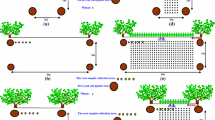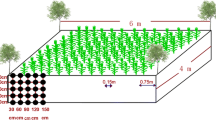Abstract
Even though agronomists have considered the spatial root distribution of plants to be important for interspecific interactions in agricultural intercropping, few experimental studies have quantified patterns of root distribution and their impacts on interspecific interactions in agroforestry systems. A field experiment was conducted to investigate the relationship between root distribution and interspecific interactions between intercropped jujube tree (Zizyphus jujuba Mill.) and wheat (Triticum aestivum Linn.) in Hetian, south Xinjiang province, northwest China. Roots were sampled by auger in 2-, 4- and 6-year-old jujube tree/wheat intercropping and in sole wheat and 2-, 4- and 6-year-old sole jujube down to 100 cm depth in the soil profile. The roots of both intercropped wheat and jujube had less root length density (RLD) at all soil depths than those of sole wheat and jujube trees. The RLD of 6-year-old jujube intercropped with wheat at different soil depths was influenced by intercropping to a smaller extent than in other jujube/wheat intercropping combinations. 6-year-old jujube exhibited a stronger negative effect on the productivity of wheat than did 2- or 4-year-old jujube and there was less effect on productivity of jujube in the 6-year-old system than in the 2- or 4-year-old jujube trees grown in monoculture. These findings may partly explain the interspecific competition effects in jujube tree/wheat agroforestry systems.



Similar content being viewed by others
References
Ashton PS (2000) Ecological theory of diversity and its applications to mixed species plantation systems. In: Ashton MS, Montagnini F (eds) The silvicultural basis for agroforestry systems. CRC Press, Boca Raton, pp 61–77
Atkinson D, Johnson MG, Mattam D, Mercer ER (1978) The effect of orchard soil management on the uptake of nitrogen by established apple trees. J Sci Food Agric 30:129–135
Böhm W (1979) Methods of studying root systems. Springer, Berlin
Cao FL, Kimmins JP, Wang JR (2012) Competitive interactions in ginkgo and crop species mixed agroforestry systems in Jiangsu, China. Agrofor Syst 84:401–415
Chamshama SAO, Mugasha AG, Klovstad A, Haveraaen O, Maliondo SMS (1998) Growth and yield of maize alley cropped with Leucaena leucocephala and Faidherbia albida in Morogoro, Tanzan. Agrofor Syst 40:215–225
Chirko CP, Gold MA, Nguyen PV, Jiang JP (1996) Influence of direction and distance from trees on wheat yield and photosynthetic photon flux density (Q p ) in a Paulownia and wheat intercropping system. For Ecol Manag 83:171–180
Dhima KV, Lithourgidis AS, Vasilakoglou LB, Dordsas CA (2007) Competition indices of common vetch and cereal intercrops in two seeding ratios. Field Crop Res 100:249–256
Ding SS, Su PX (2010) Effects of tree shading on maize crop within a poplar-maize compound system in Hexi Corridor oasis, northwestern China. Agrofor Syst 80:117–129
Droppelmann KJ, Ephrath JE, Berliner PR (2000) Tree/crop complementarity in an arid zone runoff agroforestry system in northern Kenya. Agrofor Syst 50:1–16
Friday JB, Fownes JH (2002) Competition for light between hedgerows and maize in an alley cropping system in Hawaii, USA. Agrofor Syst 55:125–137
García-Barrios L, Ong CK (2004) Ecological interactions in simultaneous agroforestry systems in the tropics: management lessons. Agrofor Syst 61:221–236
Gillespie AR, Jose S, Mengel DB, Hoover WL, Pope PE, Seifert JR, Biehle DJ, Stall T, Benjamin TJ (2000) Defining competition vectors in a temperate alley cropping system in the midwestern USA. Agrofor Syst 48:25–40
Gruenewald H, Brandt BKV, Schneider BU, Bens O, Kendzia G, Huettl RF (2007) Agroforestry systems for the production of woody biomass for energy transformation purposes. Ecol Eng 29:319–328
Imo M, Timmer VR (2002) Growth and nutritional interactions of nutrient-loaded black spruce seedlings with greenhouse natural vegetation under greenhouse conditions. For Sci 48:77–84
Jose S, Gillespie AR, Seifert JR, Mengel DB, Pope PE (2000) Defining competition vectors in a temperate alley cropping system in the mid-western USA. 3. Competition for nitrogen and litter decomposition dynamics. Agrofor Syst 48:61–77
Jose S, Gillespie AR, Pallardy SG (2004) Interspecific interactions in temperate agroforestry. Agrofor Syst 61:237–255
Li FD, Meng P, Fu DL, Wang BP (2008) Light distribution, photosynthetic rate and yield in a Paulownia-wheat intercropping system in China. Agrofor Syst 74:163–172
Lin QY, Xing LF, Li PY, Ding XT, Duan ZA (2000) Recounting and reviewing on the scientific research literature for intercropping system of jujube and crops in China. J Shandong Agric Univ 31:91–94
Liu JQ, Halik W, Wang GS, Kasim Y (2012) Study on temporal and spatial distribution rules of characteristic fruit industry resources in Xinjiang. Agric Res Arid Areas 30:230–236
Livesley SJ, Gregory PJ, Buresh RJ (2000) Competition in tree-row agroforestry systems. 1. Distribution and dynamics of fine roots length and biomass. Plant Soil 227:149–161
Maghembe JA, Kaoneka ARS, Lulandala LLL (1986) Intercropping, weeding and spacing effects on growth and nutrient content in Leucaena leucocephala at Morogoro, Tanzania. For Ecol Manag 16:269–279
Mead R, Willey RW (1980) The concept of a land equivalent ratio and advantages in yields from intercropping. Exp Agric 16:217–228
Ong CK, Black CR, Marshall FM, Corlett JE (1996) Principles of resource capture and utilization of light and water. In: Ong CK, Huxley P (eds) Tree–crop interactions: a physiological approach. CAB International, Wallingford, pp 73–158
Raddad EY, Luukkanen O (2007) The influence of different Acacia senegal agroforestry systems on soil water and crop yields in clay soils of the Blue Nile region, Sudan. Agric Water Manag 87:61–72
Rao MR, Sharma MM, Ong CK (1990) A study of the potential of hedge row intercropping in semi-arid India using a two-way systematic design. Agrofor Syst 11:243–258
Rao MR, Sharma MM, Ong CK (1991) A tree-crop interface design and its use for evaluating the potential of hedge row intercropping. Agrofor Syst 13:143–158
Reyes T, Quiroz R, Luukkanen O (2009) Spice crop agroforestry systems in the east Usambara Mountain, Tanzania: growth analysis. Agrofor Syst 76:513–523
Rivest D, Cogliastro A, Bradley RL, Olivier A (2010) Intercropping hybrid poplar with soybean increases soil microbial biomass, mineral N supply and tree growth. Agrofor Syst 80:33–40
Schroth G (1999) A review of belowground interactions in agroforestry, focussing on mechanisms and management options. Agrofor Syst 43:5–34
Schroth G, Zech W (1995) Above- and below-ground biomass dynamics in a sole cropping and an alley cropping system with Gliricidia sepium in the semi-deciduous rainforest zone of West Africa. Agrofor Syst 31:181–198
Schroth G, Poidy N, Morshauser T, Zech W (1995) Effects of different methods of soil tillage and biomass application on crop yields and soil properties in agroforestry with high tree competition. Agric Ecosyst Environ 52:129–140
Vandermeer J (1989) The ecology of intercropping. Cambridge University Press, New York
Wanvestraut RH, Jose S, Nair PKR, Brecke BJ (2004) Competition for water in a pecan (Carya illinoensis K. Koch)—cotton (Gossypium hirsutum L.) alley cropping system in the southern United States. Agrofor Syst 60:167–179
Yin R, He Q (1997) The spatial and temporal effects of Paulownia intercropping: the case of northern China. Agrofor Syst 37:91–109
Young A (1997) Agroforestry for soil management. CAB International, Wallingford, p 276
Zamora DS, Jose S, Nair PKR, Ramsey CL (2006) Interspecific competition in a pecan-cotton alleycropping system in the southern United States: production physiology. Can J Bot 84:1686–1694
Zamora DS, Jose S, Nair PKR (2007) Morphological plasticity of cotton roots in response to interspecific competition with pecan in an alley cropping system in the southern United States. Agrofor Syst 69:107–116
Acknowledgments
This work was financially supported by the Chinese Ministry of Science and Technology (Project No. 2009BADA4B03), by the Chinese Ministry of Agriculture (Project No. 201003043-01) and by NSFC (Project No. 31121062).
Author information
Authors and Affiliations
Corresponding author
Rights and permissions
About this article
Cite this article
Zhang, W., Ahanbieke, P., Wang, B.J. et al. Root distribution and interactions in jujube tree/wheat agroforestry system. Agroforest Syst 87, 929–939 (2013). https://doi.org/10.1007/s10457-013-9609-x
Received:
Accepted:
Published:
Issue Date:
DOI: https://doi.org/10.1007/s10457-013-9609-x




